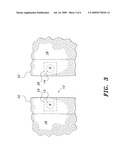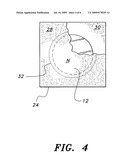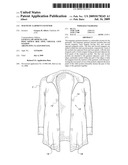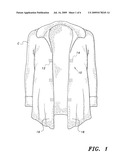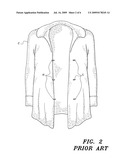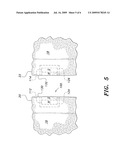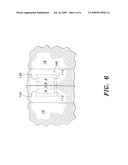Patent application title: Magnetic Garment Fastener
Inventors:
Gregory B. Albert (Charlotte, NC, US)
IPC8 Class: AA44B2100FI
USPC Class:
24303
Class name: Buckles, buttons, clasps, etc. having magnetic fastener
Publication date: 2009-07-16
Patent application number: 20090178245
ener is a releasable closure for fur garments.
The magnetic garment fastener includes first and second magnets, each
magnet having first and second opposed magnetic poles. The first and
second magnets are sealed within first and second pockets, respectively.
Each of the pockets has opposed front and rear panels, with the first
magnetic pole of each magnet being positioned adjacent the front panel of
the respective pocket. The first and second pockets are attached to the
garment adjacent a pair of free edges, preferably sealed within the pelt
of the edges to hide the magnets from the exterior of the garment, such
that positioning the rear panel of one of the pockets adjacent the front
panel of the other pocket releasably fastens the pair of free edges of
the garment together.Claims:
1. A magnetic garment fastener, comprising:first and second magnets, each
of the magnets having first and second opposed magnetic poles;first and
second pockets, the first and second magnets being secured within the
first and second pockets, respectively, each of the first and second
pockets having a front panel and a rear panel, the first magnetic pole of
each of the magnets being positioned adjacent the front panel of the
corresponding pocket, the first and second pockets being adapted for
attachment to the garment adjacent a pair of free edges of the garment so
that positioning the rear panel of one of the pockets adjacent the front
panel of the other pocket releasably fastens the free edges of the
garment together through magnetic attraction of the first and second
magnets.
2. The magnetic garment fastener as recited in claim 1, wherein the front and rear panels of each of said first and second pockets are secured to one another along peripheral edges thereof.
3. The magnetic garment fastener as recited in claim 2, further comprising stitching securing the front and rear panels of each of said first and second pockets to one another.
4. The magnetic garment fastener as recited in claim 2, further comprising adhesive securing the front and rear panels of each of said first and second pockets to one another.
5. The magnetic garment fastener as recited in claim 2, further comprising peripheral stitching about said first and second magnets securing said magnets within said first and second pockets.
6. The magnetic garment fastener as recited in claim 2, further comprising at least one layer of an adhesive formed on said first and second magnets securing said magnets within said first and second pockets.
7. A magnetic garment fastener, comprising:first and second magnets, each of the magnets having first and second opposed magnetic poles;first and second pockets, the first and second magnets being secured within the first and second pockets, each of the first and second pockets having laterally opposed free and fixed edges, the first magnetic pole of the first magnet being positioned adjacent the free edge of the first pocket, the second magnetic pole of the second magnet being positioned adjacent the free edge of the second pocket, the first and second pockets being adapted for attachment adjacent a pair of free edges of a garment with the free edges of the first and second pockets being positioned adjacent the free edges of the garment so that positioning the pair of free edges of the first and second pockets adjacent to one another releasably fastens the pair of free edges of the garment together through magnetic attraction of the first and second magnets.
8. The magnetic garment fastener as recited in claim 7, wherein each of said first and second pockets comprises opposed front and rear panels secured to one another along peripheral edges thereof.
9. The magnetic garment fastener as recited in claim 8, further comprising stitching securing the front and rear panels of each of said first and second pockets to one another.
10. The magnetic garment fastener as recited in claim 8, further comprising adhesive securing the front and rear panels of each of said first and second pockets to one another.
11. The magnetic garment fastener as recited in claim 8, further comprising peripheral stitching about said first and second magnets securing said magnets within said first and second pockets.
12. The magnetic garment fastener as recited in claim 8, further comprising at least one layer of an adhesive formed on said first and second magnets securing said magnets within said first and second pockets.
13. A garment having magnetic fasteners, comprising:a garment having a pair of opposed free edges;first and second magnets, each of the magnets having first and second opposed magnetic poles;first and second pockets, the first and second magnets being secured within the first and second pockets, respectively, the first and second pockets being attached to the garment adjacent the free edges of the garment so that positioning the opposed magnetic poles of the first and second magnets adjacent one another releasably closes the opposed free edges of the garment through magnetic attraction of the first and second magnets.
14. The magnetic garment fastener as recited in claim 13, each of said first and second pockets comprises opposed front and rear panels, wherein the front and rear panels of each of said first and second pockets are secured to one another along peripheral edges thereof.
15. The magnetic garment fastener as recited in claim 14, further comprising stitching securing the front and rear panels of each of said first and second pockets to one another.
16. The magnetic garment fastener as recited in claim 14, further comprising adhesive securing the front and rear panels of each of said first and second pockets to one another.
17. The magnetic garment fastener as recited in claim 14, further comprising peripheral stitching about said first and second magnets securing said magnets within said first and second pockets.
18. The magnetic garment fastener as recited in claim 14, further comprising at least one layer of an adhesive formed on said first and second magnets securing said magnets within said first and second pockets.Description:
CROSS-REFERENCE TO RELATED APPLICATION
[0001]This application claims the benefit of U.S. Provisional Patent Application Ser. No. 61/006,448, filed Jan. 14, 2008.
BACKGROUND OF THE INVENTION
[0002]1. Field of the Invention
[0003]The present invention relates to releasable fasteners for garments, and particularly to a magnetic garment fastener that forms a garment closure. The magnetic garment fastener is particularly used for releasably closing fur garments.
[0004]2. Description of the Related Art
[0005]Fur coats typically include closures for sealing the open front flaps or panels of the coat. Such closures may include mating hooks and eyes, or buttons and buttonholes, buttons and loops, or other conventional fasteners. In the exemplary prior art coat C illustrated in FIG. 2, the front panels are releasably closed via hooks H, formed adjacent the edge of one front panel, and loops L, formed adjacent the edge of the opposite front panel. Such closures are not only unreliable, in that they may become easily unfastened, but are also unwieldy and awkward to use. Also, as seen in the exemplary prior art coat of FIG. 2, such bulky fasteners are highly visible, thus marring the aesthetic appearance of the coat, sometimes appearing to be flaws in the fur of the coat. It would be desirable to provide a reliable fastener that can be used with garments without detracting from the aesthetic appearance of the garment, particularly high-end garments, such as fur coats, which are valued for the natural appearance of the fur or other material forming the garment. Thus, a magnetic garment fastener solving the aforementioned problems is desired.
SUMMARY OF THE INVENTION
[0006]The magnetic garment fastener is a releasable closure for garments, such as fur coats. The magnetic garment fastener includes first and second magnets, each of the magnets having first and second opposed magnetic poles (i.e., north and south poles). First and second magnets are sealed within first and second pockets, respectively. Each of the first and second pockets has opposed front and rear panels. The first magnetic pole of each magnet may be positioned adjacent the front panel of its respective pocket.
[0007]In one embodiment, the first and second magnets, and the respective first and second pockets, are attached adjacent a pair of free edges of the garment so that positioning the rear panel of one of the pockets adjacent the front panel of the other pocket releasably fastens the pair of free edges of the garment together through magnetic attraction, i.e., the north face of one magnet is attracted to, and overlaps, the south face of the other magnet, or vice-versa.
[0008]Alternatively, the first and second pockets may be formed having laterally opposed free and fixed edges, with the first magnetic pole of the first magnet being positioned adjacent the free edge of the first pocket, and the second magnetic pole of the second magnet being positioned adjacent the free edge of the second pocket. The first and second magnets, within the first and second pockets, are attached adjacent a pair of free edges of the garment, with the free edges of the first and second pockets being positioned adjacent the free edges of the garment, so that positioning the pair of free edges of the first and second pockets adjacent to one another releasably fastens the pair of free edges of the garment together through magnetic attraction.
[0009]These and other features of the present invention will become readily apparent upon further review of the following specification and drawings.
BRIEF DESCRIPTION OF THE DRAWINGS
[0010]FIG. 1 is an environmental, perspective view of a coat having magnetic garment fasteners according to the present invention.
[0011]FIG. 2 is an environmental, perspective view of a coat having exemplary conventional fasteners of the prior art.
[0012]FIG. 3 is a partial environmental front view of opposing garment edges of a garment having a magnetic garment fastener according to the present invention incorporated therein.
[0013]FIG. 4 is a partially front view of a magnetic garment fastener according to the present invention, with the pocket partially broken away to show the interior of the pocket.
[0014]FIG. 5 is a partial environmental front view of opposing garment edges of a garment similar to FIG. 3, but having an alternative embodiment of a magnetic garment fastener according to the present invention, shown with the garment unfastened.
[0015]FIG. 6 is a partial environmental front view of the magnetic garment fastener of FIG. 5, shown with the garment fastened.
[0016]Similar reference characters denote corresponding features consistently throughout the attached drawings.
DETAILED DESCRIPTION OF THE PREFERRED EMBODIMENTS
[0017]The present invention is directed towards a magnetic garment fastener, with a first embodiment of the fastener being generally designated as 10 in FIGS. 1 and 3. As shown in FIG. 1, the magnetic garment fastener 10 is a releasable closure for garments, such as exemplary fur coat C. The magnetic garment fastener includes first and second magnets 12, 14 (best shown in FIG. 3), with each magnet 12, 14 having first and second opposed magnetic poles (i.e., north and south poles). In FIGS. 3 and 4, magnets 12, are shown as having a substantially circular cross-sectional shape. It should be understood that magnets 12, 14 may have any suitable dimensions or configuration, depending upon the particular nature of the garment. Exemplary dimensions include a diameter of approximately one inch, and a thickness of approximately 1/8 of an inch. Magnets 12, 14 may be formed from any suitable, permanent magnetic material, such as neodymium, having sufficient strength to keep the fur coat C fastened during normal wear. Although the magnetic fastener may be used with any type of garment, it is particularly useful for fastening fur coats.
[0018]As shown in FIGS. 3 and 4, first and second pockets 24, 26 are provided, with the first and second magnets 12, 14 being sealed within the first and second pockets 24, 26, respectively. FIG. 4 illustrates first magnet sealed within first pocket 24, although it should be understood that second magnet 14 and second pocket 26 have an identical construction. As shown in FIG. 4, magnet 12 is preferably secured within pocket 24 by stitching 32, although it should be understood that magnet 12 may be secured in pocket 24 in any suitable manner that maintains the orientation of the magnet 12, such as by the usage of adhesives formed on each face of the magnet or the like. Each pocket 24, 26 is sealed around its edges and, as shown, may have a substantially square or rectangular shape, although the size and shape of each pocket depends upon the nature of the garment.
[0019]Each of the first and second pockets 24, 26 has opposed front and rear panels 28, 30, with the first magnetic pole of each magnet 12, 14 being positioned adjacent the front panel 28 of the respective first or second pocket 24, 26. In FIGS. 3 and 4, the north poles N of magnets 12, 14 are shown facing towards the front, and the opposed south poles face towards the rear. It should be understood that this orientation may be reversed. Each pocket 24, 26 is preferably formed from a pair of fabric panels stitched together (or otherwise secured, such as by adhesives or the like) about their peripheral edges (which may include the entire periphery of the pocket), with the corresponding magnet 12, 14 being held centrally therein by stitching 32 around the entire periphery of the magnet 12, 14. It should be understood that stitching 32 may be replaced by adhesives or any other suitable means of securing the magnet within the pocket. Exemplary dimensions for the pockets include a length of approximately 13/4 inches and a width of approximately 13/4 inches.
[0020]As shown in FIG. 3, the first and second magnets 12, 14, and respective first and second pockets 24, 26, are attached to the coat C adjacent a pair of free edges of the garment C so that positioning the rear face of one of the pockets 24, 26 adjacent the front face of the other pocket 24, 26 fastens the pair of free edges together through magnetic attraction, i.e., the north face of one magnet 12, 14 is attracted to and overlaps the south face of the other magnet 12, 14, or vice-versa. In FIG. 3, first pocket 24 is shown stitched into the folded edge 20 of first front panel 16 of coat C, and second pocket 26 is shown stitched into the folded edge 22 of second front panel 18 of coat C. Either folded edge 20, 22 may be positioned over the other, in an overlapping fashion in order to close the front panels 16, 18 together. Each pocket 24, 26 may be stitched within the coat C, may be attached thereto by adhesive or the like, or may be attached to the coat C by any other suitable fastener. As a further alternative, the pockets may be removed, with magnets having openings formed therethrough being provided. The openings are provided for the magnets to be directly stitched into the edges of the garment, without the need of additional pockets.
[0021]In the alternative embodiment of FIGS. 5 and 6, magnetic garment fastener 100 includes a pair of magnets 112, 114, sealed within pockets 124, 126, respectively, in a manner similar to that described above with reference to FIGS. 3 and 4. In the embodiment of FIGS. 5 and 6, each of the first and second pockets 124, 126 is preferably formed having laterally opposed free and fixed edges, with the first magnetic pole (the south pole S in the exemplary configuration of FIGS. 5 and 6) of the first magnet 112 being positioned adjacent the free edge of the first pocket 124, and the second magnetic pole (the north pole N) of the second magnet 114 being positioned adjacent the free edge of the second pocket 126.
[0022]The first and second magnets 112, 114, within the first and second pockets 124, 126, are attached to the coat C adjacent the free edges 130, 132 of opposing panels 16, 18, respectively, with the free edges of the first and second pockets 124, 126 being positioned adjacent the free edges of the garment C. As shown in FIG. 6, positioning the pair of free edges 130, of the first and second pockets 124, 126 adjacent to one another releasably closes or fastens the pair of free edges 130, 132 of the garment C together through magnetic attraction.
[0023]It should be understood that the orientation of magnets 124, may be reversed, i.e., the north pole N of first magnet 112 may be positioned adjacent free edge 130 and the south pole S of the second magnet 114 may be positioned adjacent free edge 132. Magnets 112, 114 may be substantially flat, planar magnets having their poles oriented outward from opposing lateral edges of the magnets 12, 14, rather than opposing faces of the magnets. Alternatively, magnets 112, 114 may be elongated bar magnets with their poles oriented towards the opposing ends, being aligned in the pockets 124, 126 so that the magnets 112, 114 attract each other end to end to fasten or close the front of the coat. Further, though shown as being bar magnets with a substantially rectangular cross-sectional contour and having poles directed towards lateral edges of the magnets 112, 114, rather than ends of the magnets 112, 114, it should be understood that first and second magnets 112, 114 may have any suitable size or shape, depending upon the nature of garment C. Exemplary dimensions for magnets 112, 114 of FIGS. 5 and 6 include a length of approximately one inch, a width of approximately 10/32 of an inch, and a thickness of approximately 5/32 of an inch. Pockets 124, 126 may be formed in a manner similar to those described above with regard to FIGS. 3 and 4, or may each be formed from a single fabric panel, folded along a central, symmetric axis and stitched along the peripheral edges thereof. Exemplary dimensions for this fabric panel include a length of approximately two inches and a width of approximately 11/2 inches.
[0024]It is to be understood that the present invention is not limited to the embodiments described above, but encompasses any and all embodiments within the scope of the following claims.
Claims:
1. A magnetic garment fastener, comprising:first and second magnets, each
of the magnets having first and second opposed magnetic poles;first and
second pockets, the first and second magnets being secured within the
first and second pockets, respectively, each of the first and second
pockets having a front panel and a rear panel, the first magnetic pole of
each of the magnets being positioned adjacent the front panel of the
corresponding pocket, the first and second pockets being adapted for
attachment to the garment adjacent a pair of free edges of the garment so
that positioning the rear panel of one of the pockets adjacent the front
panel of the other pocket releasably fastens the free edges of the
garment together through magnetic attraction of the first and second
magnets.
2. The magnetic garment fastener as recited in claim 1, wherein the front and rear panels of each of said first and second pockets are secured to one another along peripheral edges thereof.
3. The magnetic garment fastener as recited in claim 2, further comprising stitching securing the front and rear panels of each of said first and second pockets to one another.
4. The magnetic garment fastener as recited in claim 2, further comprising adhesive securing the front and rear panels of each of said first and second pockets to one another.
5. The magnetic garment fastener as recited in claim 2, further comprising peripheral stitching about said first and second magnets securing said magnets within said first and second pockets.
6. The magnetic garment fastener as recited in claim 2, further comprising at least one layer of an adhesive formed on said first and second magnets securing said magnets within said first and second pockets.
7. A magnetic garment fastener, comprising:first and second magnets, each of the magnets having first and second opposed magnetic poles;first and second pockets, the first and second magnets being secured within the first and second pockets, each of the first and second pockets having laterally opposed free and fixed edges, the first magnetic pole of the first magnet being positioned adjacent the free edge of the first pocket, the second magnetic pole of the second magnet being positioned adjacent the free edge of the second pocket, the first and second pockets being adapted for attachment adjacent a pair of free edges of a garment with the free edges of the first and second pockets being positioned adjacent the free edges of the garment so that positioning the pair of free edges of the first and second pockets adjacent to one another releasably fastens the pair of free edges of the garment together through magnetic attraction of the first and second magnets.
8. The magnetic garment fastener as recited in claim 7, wherein each of said first and second pockets comprises opposed front and rear panels secured to one another along peripheral edges thereof.
9. The magnetic garment fastener as recited in claim 8, further comprising stitching securing the front and rear panels of each of said first and second pockets to one another.
10. The magnetic garment fastener as recited in claim 8, further comprising adhesive securing the front and rear panels of each of said first and second pockets to one another.
11. The magnetic garment fastener as recited in claim 8, further comprising peripheral stitching about said first and second magnets securing said magnets within said first and second pockets.
12. The magnetic garment fastener as recited in claim 8, further comprising at least one layer of an adhesive formed on said first and second magnets securing said magnets within said first and second pockets.
13. A garment having magnetic fasteners, comprising:a garment having a pair of opposed free edges;first and second magnets, each of the magnets having first and second opposed magnetic poles;first and second pockets, the first and second magnets being secured within the first and second pockets, respectively, the first and second pockets being attached to the garment adjacent the free edges of the garment so that positioning the opposed magnetic poles of the first and second magnets adjacent one another releasably closes the opposed free edges of the garment through magnetic attraction of the first and second magnets.
14. The magnetic garment fastener as recited in claim 13, each of said first and second pockets comprises opposed front and rear panels, wherein the front and rear panels of each of said first and second pockets are secured to one another along peripheral edges thereof.
15. The magnetic garment fastener as recited in claim 14, further comprising stitching securing the front and rear panels of each of said first and second pockets to one another.
16. The magnetic garment fastener as recited in claim 14, further comprising adhesive securing the front and rear panels of each of said first and second pockets to one another.
17. The magnetic garment fastener as recited in claim 14, further comprising peripheral stitching about said first and second magnets securing said magnets within said first and second pockets.
18. The magnetic garment fastener as recited in claim 14, further comprising at least one layer of an adhesive formed on said first and second magnets securing said magnets within said first and second pockets.
Description:
CROSS-REFERENCE TO RELATED APPLICATION
[0001]This application claims the benefit of U.S. Provisional Patent Application Ser. No. 61/006,448, filed Jan. 14, 2008.
BACKGROUND OF THE INVENTION
[0002]1. Field of the Invention
[0003]The present invention relates to releasable fasteners for garments, and particularly to a magnetic garment fastener that forms a garment closure. The magnetic garment fastener is particularly used for releasably closing fur garments.
[0004]2. Description of the Related Art
[0005]Fur coats typically include closures for sealing the open front flaps or panels of the coat. Such closures may include mating hooks and eyes, or buttons and buttonholes, buttons and loops, or other conventional fasteners. In the exemplary prior art coat C illustrated in FIG. 2, the front panels are releasably closed via hooks H, formed adjacent the edge of one front panel, and loops L, formed adjacent the edge of the opposite front panel. Such closures are not only unreliable, in that they may become easily unfastened, but are also unwieldy and awkward to use. Also, as seen in the exemplary prior art coat of FIG. 2, such bulky fasteners are highly visible, thus marring the aesthetic appearance of the coat, sometimes appearing to be flaws in the fur of the coat. It would be desirable to provide a reliable fastener that can be used with garments without detracting from the aesthetic appearance of the garment, particularly high-end garments, such as fur coats, which are valued for the natural appearance of the fur or other material forming the garment. Thus, a magnetic garment fastener solving the aforementioned problems is desired.
SUMMARY OF THE INVENTION
[0006]The magnetic garment fastener is a releasable closure for garments, such as fur coats. The magnetic garment fastener includes first and second magnets, each of the magnets having first and second opposed magnetic poles (i.e., north and south poles). First and second magnets are sealed within first and second pockets, respectively. Each of the first and second pockets has opposed front and rear panels. The first magnetic pole of each magnet may be positioned adjacent the front panel of its respective pocket.
[0007]In one embodiment, the first and second magnets, and the respective first and second pockets, are attached adjacent a pair of free edges of the garment so that positioning the rear panel of one of the pockets adjacent the front panel of the other pocket releasably fastens the pair of free edges of the garment together through magnetic attraction, i.e., the north face of one magnet is attracted to, and overlaps, the south face of the other magnet, or vice-versa.
[0008]Alternatively, the first and second pockets may be formed having laterally opposed free and fixed edges, with the first magnetic pole of the first magnet being positioned adjacent the free edge of the first pocket, and the second magnetic pole of the second magnet being positioned adjacent the free edge of the second pocket. The first and second magnets, within the first and second pockets, are attached adjacent a pair of free edges of the garment, with the free edges of the first and second pockets being positioned adjacent the free edges of the garment, so that positioning the pair of free edges of the first and second pockets adjacent to one another releasably fastens the pair of free edges of the garment together through magnetic attraction.
[0009]These and other features of the present invention will become readily apparent upon further review of the following specification and drawings.
BRIEF DESCRIPTION OF THE DRAWINGS
[0010]FIG. 1 is an environmental, perspective view of a coat having magnetic garment fasteners according to the present invention.
[0011]FIG. 2 is an environmental, perspective view of a coat having exemplary conventional fasteners of the prior art.
[0012]FIG. 3 is a partial environmental front view of opposing garment edges of a garment having a magnetic garment fastener according to the present invention incorporated therein.
[0013]FIG. 4 is a partially front view of a magnetic garment fastener according to the present invention, with the pocket partially broken away to show the interior of the pocket.
[0014]FIG. 5 is a partial environmental front view of opposing garment edges of a garment similar to FIG. 3, but having an alternative embodiment of a magnetic garment fastener according to the present invention, shown with the garment unfastened.
[0015]FIG. 6 is a partial environmental front view of the magnetic garment fastener of FIG. 5, shown with the garment fastened.
[0016]Similar reference characters denote corresponding features consistently throughout the attached drawings.
DETAILED DESCRIPTION OF THE PREFERRED EMBODIMENTS
[0017]The present invention is directed towards a magnetic garment fastener, with a first embodiment of the fastener being generally designated as 10 in FIGS. 1 and 3. As shown in FIG. 1, the magnetic garment fastener 10 is a releasable closure for garments, such as exemplary fur coat C. The magnetic garment fastener includes first and second magnets 12, 14 (best shown in FIG. 3), with each magnet 12, 14 having first and second opposed magnetic poles (i.e., north and south poles). In FIGS. 3 and 4, magnets 12, are shown as having a substantially circular cross-sectional shape. It should be understood that magnets 12, 14 may have any suitable dimensions or configuration, depending upon the particular nature of the garment. Exemplary dimensions include a diameter of approximately one inch, and a thickness of approximately 1/8 of an inch. Magnets 12, 14 may be formed from any suitable, permanent magnetic material, such as neodymium, having sufficient strength to keep the fur coat C fastened during normal wear. Although the magnetic fastener may be used with any type of garment, it is particularly useful for fastening fur coats.
[0018]As shown in FIGS. 3 and 4, first and second pockets 24, 26 are provided, with the first and second magnets 12, 14 being sealed within the first and second pockets 24, 26, respectively. FIG. 4 illustrates first magnet sealed within first pocket 24, although it should be understood that second magnet 14 and second pocket 26 have an identical construction. As shown in FIG. 4, magnet 12 is preferably secured within pocket 24 by stitching 32, although it should be understood that magnet 12 may be secured in pocket 24 in any suitable manner that maintains the orientation of the magnet 12, such as by the usage of adhesives formed on each face of the magnet or the like. Each pocket 24, 26 is sealed around its edges and, as shown, may have a substantially square or rectangular shape, although the size and shape of each pocket depends upon the nature of the garment.
[0019]Each of the first and second pockets 24, 26 has opposed front and rear panels 28, 30, with the first magnetic pole of each magnet 12, 14 being positioned adjacent the front panel 28 of the respective first or second pocket 24, 26. In FIGS. 3 and 4, the north poles N of magnets 12, 14 are shown facing towards the front, and the opposed south poles face towards the rear. It should be understood that this orientation may be reversed. Each pocket 24, 26 is preferably formed from a pair of fabric panels stitched together (or otherwise secured, such as by adhesives or the like) about their peripheral edges (which may include the entire periphery of the pocket), with the corresponding magnet 12, 14 being held centrally therein by stitching 32 around the entire periphery of the magnet 12, 14. It should be understood that stitching 32 may be replaced by adhesives or any other suitable means of securing the magnet within the pocket. Exemplary dimensions for the pockets include a length of approximately 13/4 inches and a width of approximately 13/4 inches.
[0020]As shown in FIG. 3, the first and second magnets 12, 14, and respective first and second pockets 24, 26, are attached to the coat C adjacent a pair of free edges of the garment C so that positioning the rear face of one of the pockets 24, 26 adjacent the front face of the other pocket 24, 26 fastens the pair of free edges together through magnetic attraction, i.e., the north face of one magnet 12, 14 is attracted to and overlaps the south face of the other magnet 12, 14, or vice-versa. In FIG. 3, first pocket 24 is shown stitched into the folded edge 20 of first front panel 16 of coat C, and second pocket 26 is shown stitched into the folded edge 22 of second front panel 18 of coat C. Either folded edge 20, 22 may be positioned over the other, in an overlapping fashion in order to close the front panels 16, 18 together. Each pocket 24, 26 may be stitched within the coat C, may be attached thereto by adhesive or the like, or may be attached to the coat C by any other suitable fastener. As a further alternative, the pockets may be removed, with magnets having openings formed therethrough being provided. The openings are provided for the magnets to be directly stitched into the edges of the garment, without the need of additional pockets.
[0021]In the alternative embodiment of FIGS. 5 and 6, magnetic garment fastener 100 includes a pair of magnets 112, 114, sealed within pockets 124, 126, respectively, in a manner similar to that described above with reference to FIGS. 3 and 4. In the embodiment of FIGS. 5 and 6, each of the first and second pockets 124, 126 is preferably formed having laterally opposed free and fixed edges, with the first magnetic pole (the south pole S in the exemplary configuration of FIGS. 5 and 6) of the first magnet 112 being positioned adjacent the free edge of the first pocket 124, and the second magnetic pole (the north pole N) of the second magnet 114 being positioned adjacent the free edge of the second pocket 126.
[0022]The first and second magnets 112, 114, within the first and second pockets 124, 126, are attached to the coat C adjacent the free edges 130, 132 of opposing panels 16, 18, respectively, with the free edges of the first and second pockets 124, 126 being positioned adjacent the free edges of the garment C. As shown in FIG. 6, positioning the pair of free edges 130, of the first and second pockets 124, 126 adjacent to one another releasably closes or fastens the pair of free edges 130, 132 of the garment C together through magnetic attraction.
[0023]It should be understood that the orientation of magnets 124, may be reversed, i.e., the north pole N of first magnet 112 may be positioned adjacent free edge 130 and the south pole S of the second magnet 114 may be positioned adjacent free edge 132. Magnets 112, 114 may be substantially flat, planar magnets having their poles oriented outward from opposing lateral edges of the magnets 12, 14, rather than opposing faces of the magnets. Alternatively, magnets 112, 114 may be elongated bar magnets with their poles oriented towards the opposing ends, being aligned in the pockets 124, 126 so that the magnets 112, 114 attract each other end to end to fasten or close the front of the coat. Further, though shown as being bar magnets with a substantially rectangular cross-sectional contour and having poles directed towards lateral edges of the magnets 112, 114, rather than ends of the magnets 112, 114, it should be understood that first and second magnets 112, 114 may have any suitable size or shape, depending upon the nature of garment C. Exemplary dimensions for magnets 112, 114 of FIGS. 5 and 6 include a length of approximately one inch, a width of approximately 10/32 of an inch, and a thickness of approximately 5/32 of an inch. Pockets 124, 126 may be formed in a manner similar to those described above with regard to FIGS. 3 and 4, or may each be formed from a single fabric panel, folded along a central, symmetric axis and stitched along the peripheral edges thereof. Exemplary dimensions for this fabric panel include a length of approximately two inches and a width of approximately 11/2 inches.
[0024]It is to be understood that the present invention is not limited to the embodiments described above, but encompasses any and all embodiments within the scope of the following claims.
User Contributions:
Comment about this patent or add new information about this topic:
| People who visited this patent also read: | |
| Patent application number | Title |
|---|---|
| 20180293559 | PROCESSING DATA SERVICE |
| 20180293557 | METHOD OF CHARGING ELECTRONIC CURRENCY AUTOMATICALLY BASED ON BLOCKCHAIN AND SYSTEM THEREOF |
| 20180293556 | METHOD AND SYSTEM FOR PROCESSING BLOCKCHAIN-BASED REAL-TIME TRANSACTION |
| 20180293555 | Systems and Methods for Cryptocurrency Transactions in Aircraft |
| 20180293554 | ELECTRONIC FUNDS AND RECEIPT TRANSFER SYSTEM |

